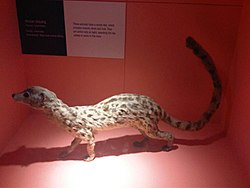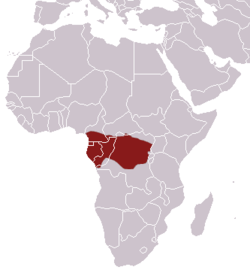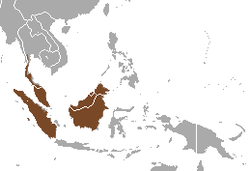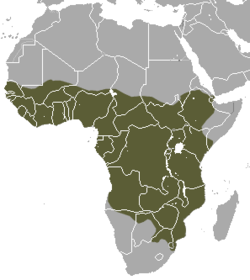| Common name | Scientific name and subspecies | Range | Size and ecology | IUCN status and estimated population |
|---|
| Abyssinian genet 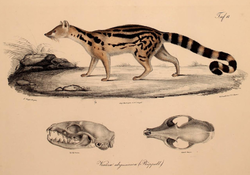 | G. abyssinica
(Rüppell, 1836) | Northeast Africa
 | Size: 40–43 cm (16–17 in) long, plus 38–41 cm (15–16 in) tail [3]
Habitat: Forest, shrubland, and grassland [4]
Diet: Primarily eats rodents, birds, and seeds, as well as insects and fruit [4] [5] | DD
Unknown  [4] [4]
|
|---|
| Angolan genet  | G. angolensis
Bocage, 1882 | Scattered south-central Africa
 | Size: 44–48 cm (17–19 in) long, plus 38–43 cm (15–17 in) tail [3]
Habitat: Savanna [6]
Diet: Believed to primarily eat insects, as well as fruit [6] [5] | LC
Unknown  [6] [6]
|
|---|
| Aquatic genet  | G. piscivora
(Allen, 1919) | Central Africa
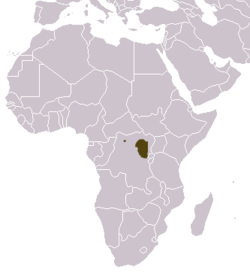 | Size: 44–50 cm (17–20 in) long, plus 34–42 cm (13–17 in) tail [5]
Habitat: Forest and inland wetlands [7]
Diet: Primarily eats fish [7] | NT
10,000  [7] [7]
|
|---|
| Bourlon's genet
| G. bourloni
Gaubert, 2003 | West Africa
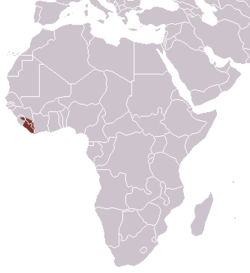 | Size: 49–50 cm (19–20 in) long, plus 40–42 cm (16–17 in) tail [5]
Habitat: Forest [8]
Diet: Unknown [8] [5] | VU
9,800  [8] [8]
|
|---|
| Cape genet  | G. tigrina
(Schreber, 1776)
| South Africa | Size: 42–58 cm (17–23 in) long, plus 38–46 cm (15–18 in) tail [5]
Habitat: Forest, shrubland, and grassland [9]
Diet: Omnivorous; primarily eats insects and small mammals [9] [5] | LC
Unknown  [9] [9]
|
|---|
| Common genet 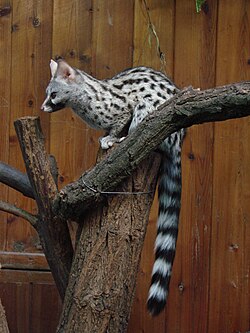 | G. genetta
(Linnaeus, 1758)
- G. g. afra
- G. g. dongolana
- G. g. felina
- G. g. genetta
- G. g. senegalensis
| Bands of north, central, and south Africa and parts of Arabian peninsula (green), introduced in southwest Europe (red), formerly introduced in Nile river area (black)
 | Size: 46–52 cm (18–20 in) long, plus 42–52 cm (17–20 in) tail [3]
Habitat: Forest, savanna, shrubland, and rocky areas [10]
Diet: Primarily eats small mammals, as well as birds, other small vertebrates, insects, and fruit [10] | LC
Unknown  [10] [10]
|
|---|
| Crested servaline genet  | G. cristata
Hayman, 1940 | Northwest Africa
 | Size: 49–63 cm (19–25 in) long, plus 43 cm (17 in) tail [3]
Habitat: Forest [11]
Diet: Primarily eats insects, as well as small mammals, reptiles, and vegetables [11] [5] | VU
7,000  [11] [11]
|
|---|
| Giant forest genet 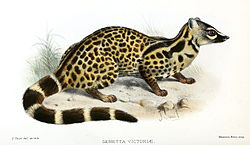 | G. victoriae
Thomas, 1902 | Central Africa
 | Size: 55–60 cm (22–24 in) long, plus 41–49 cm (16–19 in) tail [5]
Habitat: Forest [12]
Diet: Primarily eats fruit, as well as rodents, birds, and insects [12] [5] | LC
Unknown  [12] [12]
|
|---|
| Hausa genet 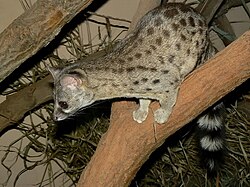 | G. thierryi
Matschie, 1902 | West Africa
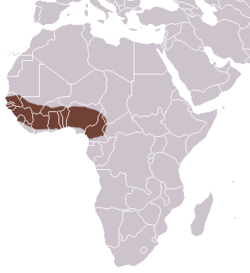 | Size: 44–45 cm (17–18 in) long, plus 40–43 cm (16–17 in) tail [3]
Habitat: Forest, savanna, and shrubland [13]
Diet: Unknown [13] [5] | LC
Unknown  [13] [13]
|
|---|
| Johnston's genet
| G. johnstoni
Pocock, 1908 | Northwest Africa
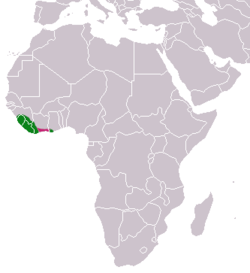 | Size: 47–52 cm (19–20 in) long, plus 46–50 cm (18–20 in) tail [5]
Habitat: Forest, savanna, and shrubland [14]
Diet: Believed to primarily eat insects [14] [5] | NT
Unknown  [14] [14]
|
|---|
| King genet
| G. poensis
Waterhouse, 1838 | Scattered parts of west Africa
 | Size: 42–68 cm (17–27 in) long, plus 35–47 cm (14–19 in) tail [5]
Habitat: Forest [15]
Diet: Unknown; believed to eat mammals and fruit [15] | DD
Unknown  [15] [15]
|
|---|
| Pardine genet  | G. pardina
Geoffroy, 1832 | Northwest Africa
 | Size: 41–56 cm (16–22 in) long, plus 39–45 cm (15–18 in) tail [5]
Habitat: Forest, savanna, and shrubland [16]
Diet: Primarily eats rodents, as well as insects, fruit, birds, and other small mammals [16] [5] | LC
Unknown  [16] [16]
|
|---|
| Rusty-spotted genet  | G. maculata
(Gray, 1830) | Central and south Africa
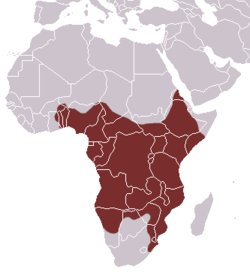 | Size: 41–53 cm (16–21 in) long, plus 39–54 cm (15–21 in) tail [3]
Habitat: Forest, savanna, and shrubland [17]
Diet: Primarily eats invertebrates, fish, amphibians, reptiles, small birds, eggs, and small mammals, as well as fruit, seeds, and berries [17] [5] | LC
Unknown  [17] [17]
|
|---|
| Servaline genet 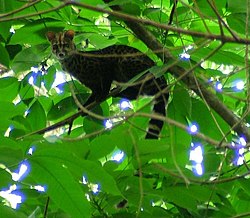 | G. servalina
Pucheran, 1855
| Central africa
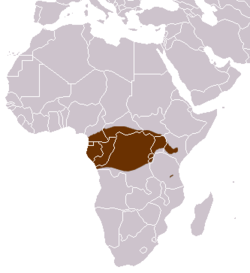 | Size: 44–51 cm (17–20 in) long, plus 36–49 cm (14–19 in) tail [5]
Habitat: Forest and shrubland [18]
Diet: Primarily eats small mammals and insects, as well as snakes, birds, and fruit [18] [5] | LC
Unknown  [18] [18]
|
|---|

























